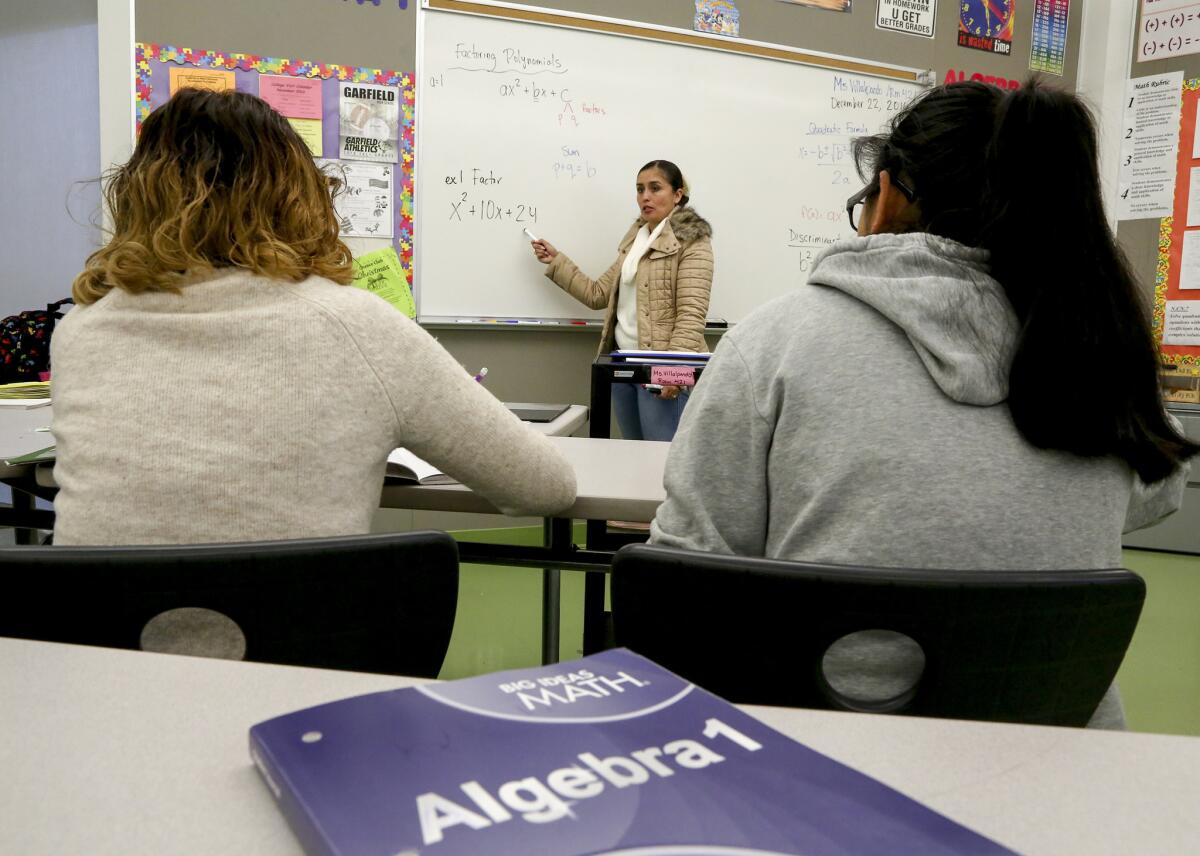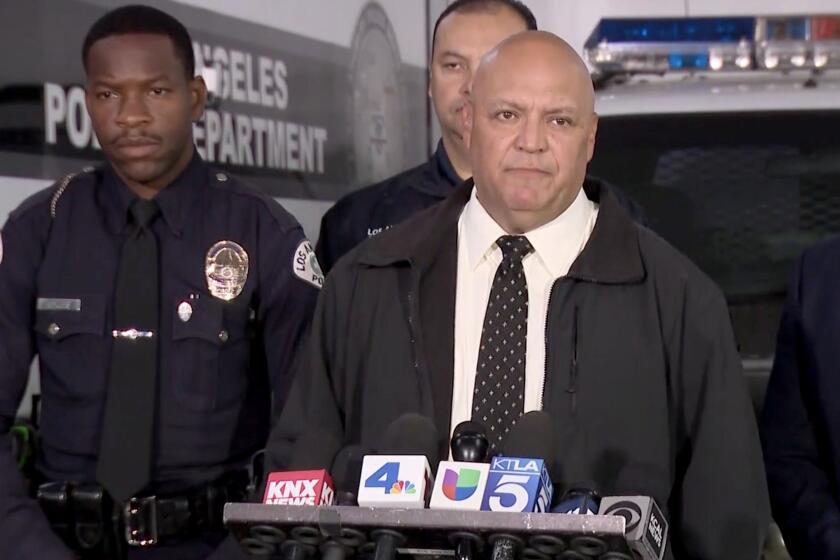Q&A: Failed a class? A guide to credit recovery in L.A. schools

The Los Angeles Unified School District has committed $45 million from 2015 through the 2018 school year to help students who failed classes make up their grades and graduate on time. But what are these “credit recovery” programs, and how do they differ from the ones that you took as a high school student?
Read our story about credit recovery in L.A. Unified, and the data that schools are missing »
Here are some key facts about how credit recovery works in L.A. Unified:
What is credit recovery?
Credit recovery is the term used to describe programs that let students make up a class they’ve failed. Some credit recovery options in L.A. Unified are ones everyone would recognize, like summer school (though the district prefers to call it “summer term”) and retaking the class during the school day, or going to a continuation school if a student is behind in a number of classes.
So what’s new about it?
In the past, these programs have existed on the periphery of most students’ experiences, often taking place during the summer or off-campus. But L.A. Unified Supt. Michelle King decided that the primary goal of her tenure would be to reach 100% graduation, a feat no large urban school district has ever achieved. To do that, she initiated an “all-hands-on-deck” effort to get kids across the graduation stage on time, and she rolled out a lot of new options so that students who have failed can make up a class quickly.
Many students now take credit recovery courses online — though often in the presence of an L.A. Unified teacher. In some cases, like with the in-person program called PASS (Performance Assessment Student Support), students can make up a failed grade in as little as a week.
When can students take these classes?
One important element of these programs is that they offer students the flexibility to make up classes when they have the time, whether it’s during the school day, after school or over a holiday or winter break. Students also can take online classes, but sometimes they have to take tests in a classroom with a teacher, or take a “blended” class in which an L.A. Unified teacher is present and instructing parts of the class.
| program | Online | Before or after school | During school | Weekends | During break | Anytime |
|---|---|---|---|---|---|---|
| programApex or Edgenuity Students can take a course online through these vendors. There are also "blended' versions with L.A. Unified teachers. | Online☓ | Before or after school | During school | Weekends | During break | Anytime☓ |
| programRIG (Recovery + Intervention = Graduation) Students remain enrolled in their high school, but can take a credit recovery class through a continuation school. | Online☓ | Before or after school☓ | During school☓ | Weekends | During break | Anytime |
| programCommunity college Students earn high school credit for passing a community college course that is comparable to the high school course they failed, with the principal's permission. | Online☓ | Before or after school☓ | During school☓ | Weekends☓ | During break | Anytime |
| program5th year of high school Students stay an extra year to retake courses they failed. | Online | Before or after school | During school☓ | Weekends | During break | Anytime |
| programAdult education Students take evening classes at adult schools. | Online | Before or after school☓ | During school | Weekends | During break☓ | Anytime |
| programRepeat courses Students retake the class in its entirety after failing, during the school day. | Online | Before or after school | During school☓ | Weekends | During break | Anytime |
| programSTAR 17 LAUSD calls this a "course extension," not credit recovery. If a student receives a D in a class, they can enter into a contract with a teacher to show proficiency in the parts of the class where they suffered most and raise their grade. They must complete the requirements by the end of the next semester, and the grade will be changed. Schools can also modify this program to use it for students who failed a class. | Online | Before or after school☓ | During school | Weekends☓ | During break☓ | Anytime |
| programPASS (Performance Assessment Student Support) Students complete a class they failed based on "mastery" of the material. It often happens over winter or spring break and can take as little as 30 hours (half the time you spend in a regular class). At some schools, students who use this option can only earn a C. | Online | Before or after school☓ | During school | Weekends☓ | During break☓ | Anytime |
| programHigh school summer term Courses taken at high schools over the summer to make up credits. | Online☓ | Before or after school | During school | Weekends | During break☓ | Anytime |
| programLocal design Schools can modify credit recovery programs or create their own, as long as their local district superintendent approves it. | Online | Before or after school | During school | Weekends | During break | Anytime☓ |
| programIndependent study Students enter into a contract with a teacher to complete assignments, tests and projects to make up a class. They must meet with the teacher at least once a week. | Online☓ | Before or after school | During school | Weekends | During break | Anytime☓ |
Graphics reporting by Sonali Kohli
Source: Los Angeles Unified School District
About the Terms
Apex or Edgenuity: Students can take a course online through these vendors. There are also "blended' versions with L.A. Unified teachers.
RIG (Recovery + Intervention = Graduation): Students remain enrolled in their high school, but can take a credit-recovery class through a continuation school.
Community college: Students earn high school credit for passing a community college course that is comparable to the high school course they failed, with the principal's permission.
5th year of high school: Students stay an extra year to retake courses they failed.
Adult education: Students take evening classes through adult schools.
Repeat courses: Students retake the class in its entirety after failing, during the school day.
STAR 17 (Students Taking Action for Readiness): L.A. Unified calls this a "course extension," not credit recovery. If a student receives a D in a class, he or she can enter into a contract with a teacher to show proficiency in the parts of the class where the student suffered most and raise the grade. The student must complete the requirements by the end of the next semester, and the grade will be changed. Schools can also modify this program to use it for students who failed a class.
PASS (Performance Assessment Student Support): Students complete a class they failed based on "mastery" of the material. It often happens over winter or spring break and can take as little as 30 hours (half the time spent in a regular class). At some schools, students who use this option can only earn a C.
High school summer term: Students take courses at high schools over the summer to make up credits.
Local design: Schools can modify credit-recovery programs or create their own, as long as their local district superintendent approves it.
Independent study: Students enter into a contract with a teacher to complete assignments, tests and projects to make up a class. They must meet with the teacher at least once a week.
Can my child take any of these?
Schools offer different types of credit recovery, depending on students’ needs. Talk to your academic counselor about the credit recovery programs available at your school, ask if they can introduce a new one if you’re interested in it, or ask if your student can take credit recovery at a different school.
So, is credit recovery working?
The school district’s graduation rate is increasing more quickly than before, and L.A. Unified reached a record-high 77% graduation rate for the class of 2016.
District officials say some of the increase is thanks to credit recovery, but they also highlight other improvements and tools that help counselors ensure students are on track to graduate on time.
Is the credit-recovery education the same as in a normal class?
There’s no good answer yet. It’s hard to know whether students in these classes are getting the same level of education as they would in a regular class, or even as their peers in other credit-recovery courses. The programs are run differently from school to school, and district officials don’t have records on how many students tried and failed to complete credit recovery courses, or how long it took them to finish a class.
The district hasn’t instituted across-the-board standards for what credit-recovery options schools offer or how they should teach or grade them. District officials say that personalization is important, but experts say it’s also important to keep track of how many students are entering these classes and how they fare.
L.A. Unified has applied for a federal grant to compare credit-recovery programs, and officials say the data collection is improving. But schools are still being trained.
Start your day right
Sign up for Essential California for news, features and recommendations from the L.A. Times and beyond in your inbox six days a week.
You may occasionally receive promotional content from the Los Angeles Times.




